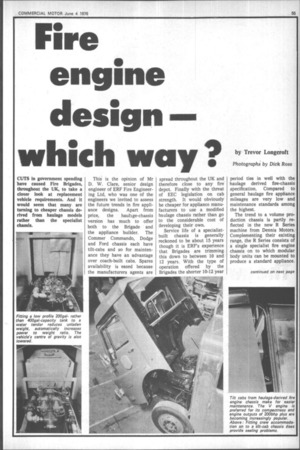design --
Page 57

If you've noticed an error in this article please click here to report it so we can fix it.
which way
CUTS in government spending have caused Fire Brigades, throughout the UK, to take a closer look at replacement vehicle requirements. And it would seem that many are turning to cheaper chassis derived from haulage models rather than the specialist chassis. This is the opinion of Mr D. W. Clare, senior design engineer of ERF Fire Engineering Ltd, who was one of the engineers we invited to assess the future trends in fire appliance designs. Apart from price, the haulage-chassis version has much to offer both to the Brigade and the appliance builder. The Commer Commando, Dodge and Ford chassis each have tilt-cabs and so for maintenance they have an advantage over coach-built cabs. Spares availability is eased because the manufacturers agents are spread throughout the UK and therefore close to any fire depot. Finally with the threat of EEC legislation on cab strength. It would obviously be cheaper for appliance manufacturers to use a modified haulage chassis rather than go to the considerable cost of developing their own.
Service life of a specialistbuilt chassis is generally reckoned to be about 15 years though it is ERF's experience that Brigades are trimming this down to between 10 and 12 years. With the type of operation offered by the Brigades the shorter 10-12 year • period ties in well with the haulage derived fire-chassis specification. Compared to general haulage fire appliance mileages are very low and maintenance standards among the highest.
The trend to a volume production chassis is partly reflected in the new R Series machine from Dennis Motors. Complementing their existing range, the R Series consists of a single specialist fire engine chassis on to which modular body units can be mounted to produce a standard appliance.
continued on next page




























































































































